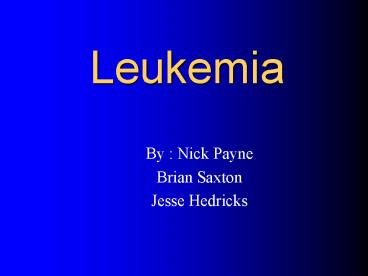Leukemia - PowerPoint PPT Presentation
1 / 20
Title: Leukemia
1
Leukemia
- By Nick Payne
- Brian Saxton
- Jesse Hedricks
2
The Background
3
What is cancer?
- Cancer is the general name for a group of more
than 100 diseases in which cells in a part of the
body begin to grow out of control. - Cancer cells develop because of damage to the
DNA. - DNA gets damaged by things in the environment,
exposure to chemicals, viruses, tobacco smoke or
too much sunlight.
4
Leukemia
- Leukemia is the cancer of bone marrow, the soft,
spongy center of the bone which produces blood
cells - In most cases of leukemia, the bone marrow
produces too many immature white blood cells
called blasts that are abnormally shaped and
cannot carry out their duties.
5
Types of leukemia
- There are many types of leukemia, four main types
are - Acute Lymphoblastic Leukemia (ALL)
- Acute Myelogenous Leukemia (AML)
- Chronic Lymphocytic Leukemia (CLL)
- Chronic Myelogenous Leukemia (CML)
6
How does it effect the body?
- The regular mature leukocytes can not reproduce
and are replaced at the end of their lives.
However, leukemic cells have the ability to
reproduce but they don't have the ability to
develop sufficiently to act like the normal
leukocytes against infection. With the progress
of Leukemia, the leukemic cells replace the
regular leukocytes, leaving the patient
completely vulnerable to infection.
7
How does it effect the cell cycle?
- Normally, various cell cycle checkpoints function
to halt progression into synthesis or mitotic
phases until threshold level of growth signals is
attained, after which cell division may proceed. - In leukemia, mutations can cause an overabundance
of growth signals, or a lack of reliance on
inhibition signals, so that cells divide in an
unregulated manner.
8
Statistics
9
General leukemia
- Diagnosed 10 times more often in adults than in
children. - Leading cause of death by disease in children
between the ages of 1 and 14. - Accounts for about 30 of cancer cases in
children aged 0-15. - Each year about 30,000 new cases of leukemia are
diagnosed.
10
Acute Lymphoblastic Leukemia (ALL)
- Most common type in young children.
- Does effect adults.
- 1,460 people will die of ALL in the next year.
- 3 out of 4 of these deaths will be in adults.
11
Acute Myelogenous Leukemia (AML)
- 12,000 new cases of leukemia each year.
- Occurs in both adults and children.
- Most patients will be adults.
- 8,820 deaths per year (US 2008)
12
Chronic Lymphocytic Leukemia (CLL)
- CLL is responsible for about 9,700 new cases of
leukemia each year. Most often, people diagnosed
with the disease are older than 55. It almost
never affects children. - 15,110 new cases (US 2008)
- 4,390 people will die ( US 2008)
- Accounts for 1-3 of all leukemia.
13
Chronic Myelogenous Leukemia (CML)
- 4,830 new cases of CML (US, 2008)
- 450 people will die of CML (US, 2008)
- CML accounts for about 10 to 15 of all
leukemia. - Risk 1 in 500.
14
Treatment
15
Chemotherapy
- Chemotherapy is the major form of treatment for
leukemia. - This treatment uses chemical agents to kill
leukemia cells. Depending on the type of leukemia
you have, you may receive a single drug or a
combination of one or more drugs. - These drugs may come in a pill form, or they may
be injected directly into a vein.
16
Drug (ATRA)
- Arsenic Trioxide and all-trans retinoic acid
(ATRA) are anti-cancer drugs that doctors can use
alone. - These drugs cause leukemia cells with a specific
gene mutation to mature and die.
17
Radiation Therapy
- Uses X-rays or other high-energy rays to damage
leukemia cells and stop their growth. - May be concentrated to one area, or to whole body.
18
Bone Marrow Transplant
- Replaces leukemic bone marrow with leukemic-free
marrow. - High doses of chemotherapy or radiation are used
to destroy your bone marrow. - This marrow is then replaced with other bone
marrow.
19
Stem Cell Transplant
- The SCT procedure enables physicians to give
chemotherapy and radiotherapy in doses that are
strong enough to eliminate leukemia cells. - The injured bone marrow then is replenished by a
transplant of stem cells, which can manufacture
the necessary new blood cells.
20
References
- Leukemia Research Foundation
www.livingwithleukemia.org - Revolution Health www.revolutionhealth.com
- Leukemia Lymphoma Society www.leukemia-lympho
ma.org - American Cancer Society www.cancer.org
- HealthAtoZ www.healthatoz.com
- Oncology Channel www.oncologychannel.com
- Mayo Clinic www.mayoclinic.com

